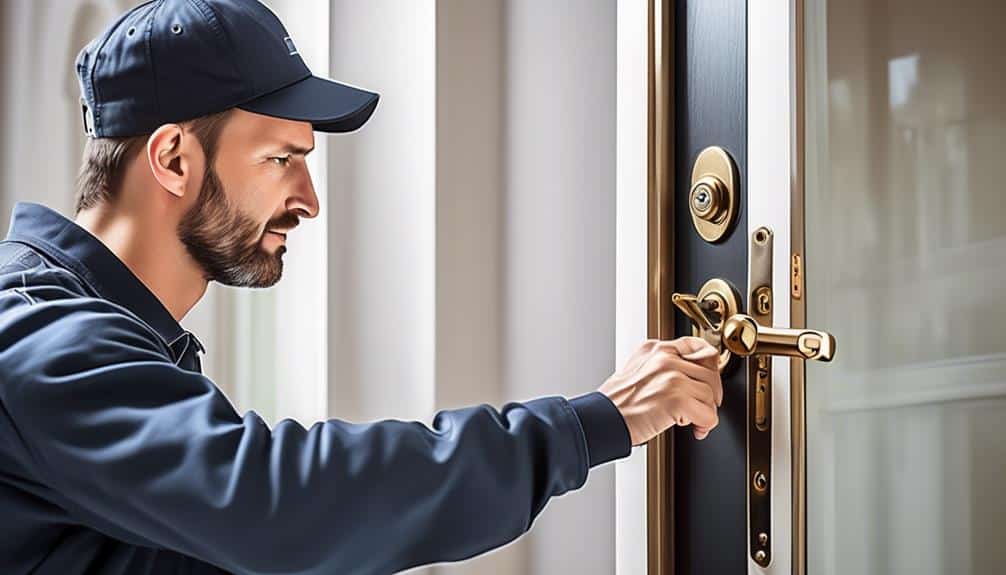Did you know that installing a lock in just 24 hours can be a quick and reliable process? Well, it's true!
When it comes to ensuring the security of your home or business, time is of the essence, and we understand that.
That's why we're here to provide you with some invaluable tips on how to install a lock efficiently and effectively.
So, if you're ready to learn the secrets to a successful lock installation, keep reading because we've got you covered.
Choose the Right Lock Type
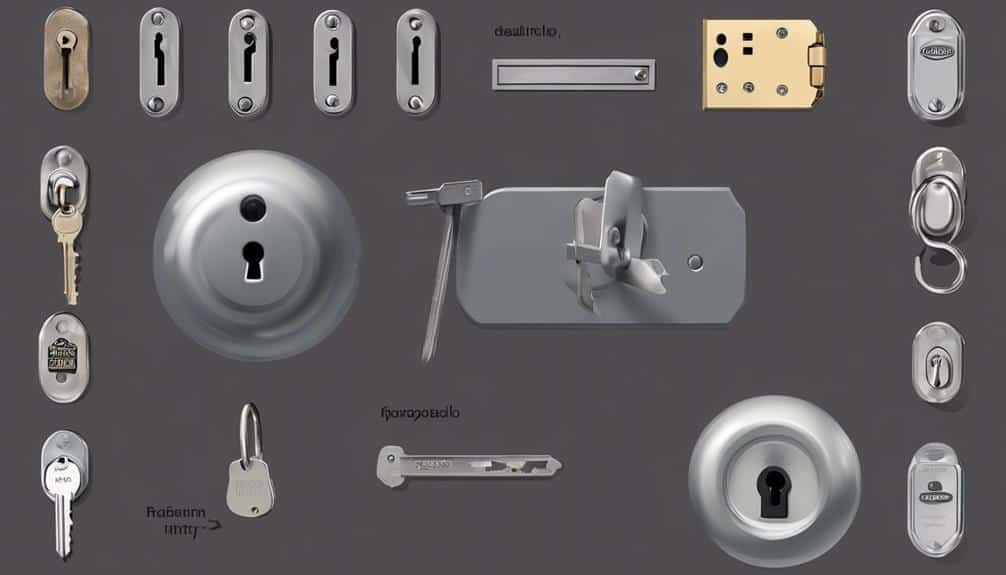
When choosing the right lock type for your 24-hour lock installation, it's essential to consider factors such as security level, durability, and compatibility with your existing door hardware.
When it comes to security features, you need to evaluate the lock's ability to resist forced entry. Look for locks that have features like anti-pick pins and reinforced strike plates. These will make it much harder for burglars to manipulate the lock and gain access to your property. Additionally, consider locks that have a higher security rating, such as Grade 1 or Grade 2 locks, as these have been tested and meet industry standards for resistance to attacks.
Durability is another important factor to consider when choosing a lock type. You want a lock that can withstand frequent use and exposure to the elements. Look for locks that are made from materials such as solid brass or stainless steel, as these are known for their durability. Additionally, consider locks that have been tested for their resistance to corrosion and wear.
Lastly, compatibility with your existing door hardware is crucial. Ensure that the lock you choose can be easily installed on your door without requiring any major modifications. This will save you time and effort during the installation process.
Gather the Necessary Tools
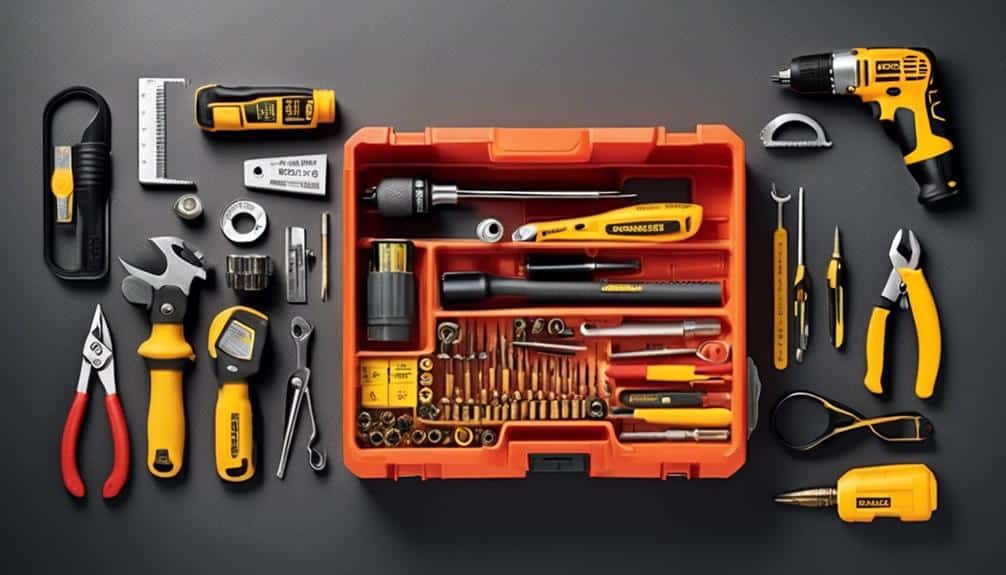
Now that you have chosen the right lock type for your 24-hour lock installation, it's time to gather the necessary tools. Having the proper tools is crucial for a smooth and successful installation process. To ensure that you have everything you need, refer to the table below:
| Tools | Quantity | Purpose |
|---|---|---|
| Screwdriver | 1 | To remove and install screws |
| Drill | 1 | To create holes for the lock and latch |
| Hole Saw | 1 | To create a clean and precise hole for the lock |
| Chisel | 1 | To mortise the door for the lock and latch |
| Tape Measure | 1 | To accurately measure the dimensions of the lock |
Lock installation troubleshooting can be avoided by using the correct tools and techniques. One common mistake to avoid during lock installation is using the wrong size screwdriver. This can lead to stripped screws or damage to the lock. Another mistake is not properly aligning the lock and latch. This can result in a lock that doesn't function correctly. It is also important to follow the manufacturer's instructions and guidelines to ensure a successful installation.
Prepare the Door for Installation
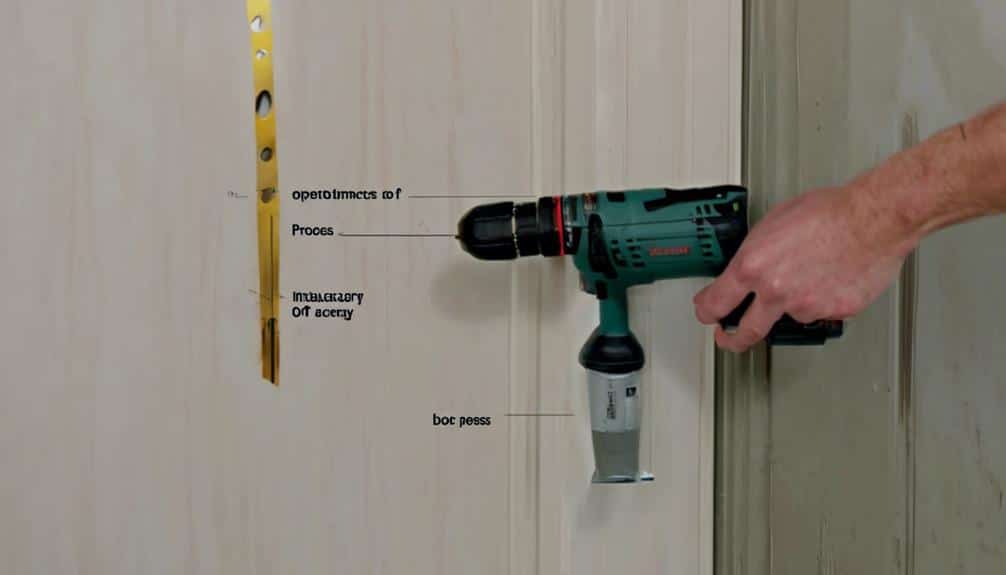
Let's begin by discussing the important points to consider when preparing the door for lock installation.
First, we need to measure the dimensions of the door to ensure the new lock fits properly.
Next, we should remove the old lock, making sure to follow the manufacturer's instructions.
Lastly, it's crucial to clean the door surface to remove any dirt or debris that could interfere with the installation process.
Measure Door Dimensions
To prepare the door for installation, we need to accurately measure its dimensions. Measuring the door dimensions is a crucial step in ensuring a proper fit for the lock installation process.
Start by measuring the height and width of the door frame. Use a tape measure to obtain precise measurements, ensuring accuracy to the nearest millimeter. Take into account any existing hardware, such as hinges or strike plates, as these may affect the overall dimensions.
Additionally, consider the thickness of the door, as it will determine the type of lock that can be installed. Accurate measurements will facilitate a seamless installation process and ensure that the lock fits securely within the door frame, providing optimal security for your property.
Remove Old Lock
Can the old lock be easily removed using basic tools and techniques?
When removing an old lock, it's important to do so safely and efficiently. Start by using a screwdriver to remove the screws on the lock plate and latch. Once the screws are removed, the lock should easily slide out of the door.
However, if the lock is stubborn or difficult to remove, using a lubricant such as WD-40 can help loosen it. It's crucial to handle the old lock with care to avoid injury, as it may have sharp edges.
When disposing of the old lock, it's recommended to check local regulations for proper disposal methods.
Clean Door Surface
To prepare the door for installation, ensure that the door surface is thoroughly cleaned. This step is crucial to ensure proper adhesion of the lock and to prevent any debris or dirt from interfering with its functionality. Here are three important points to consider when cleaning the door surface:
- Use appropriate cleaning products: Choose cleaning products specifically designed for door surfaces. Avoid abrasive cleaners or solvents that could damage the door's finish.
- Remove dirt and grime: Use a soft cloth or sponge to gently scrub the door surface, paying attention to any crevices or hard-to-reach areas. Wipe away any residue with a clean cloth.
- Perform regular door maintenance: Regularly inspect the door for any signs of wear or damage. Address any issues promptly to ensure the longevity of the lock and the security of your property.
Install the Lock Mechanism
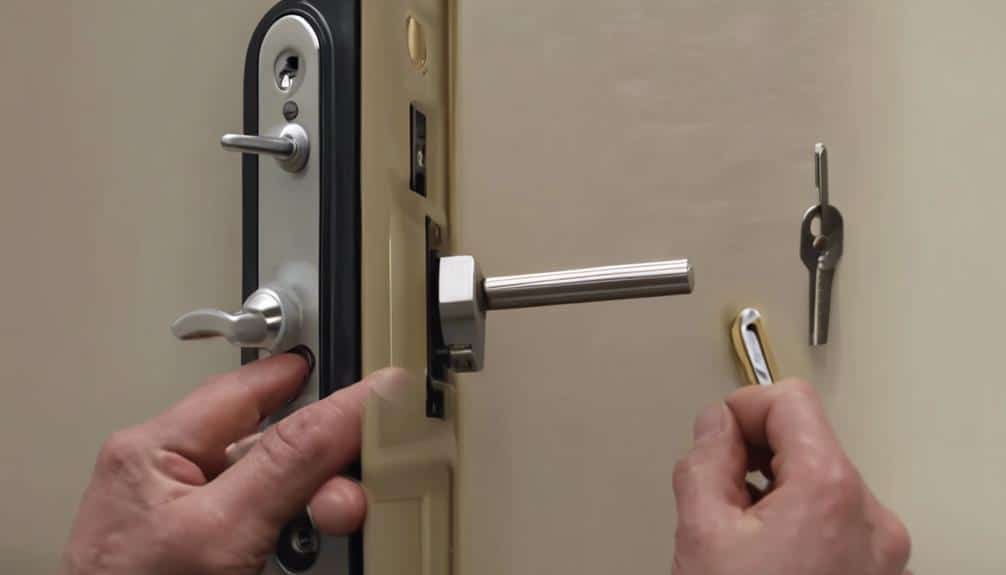
Now let's move on to the next step of lock installation: installing the lock mechanism.
In this section, we'll discuss two important points – lock alignment techniques and choosing the right tools.
Proper alignment is crucial for the lock to function smoothly and securely, and we'll provide techniques to ensure accurate placement.
Additionally, we'll guide you on selecting the appropriate tools required for this task.
Lock Alignment Techniques
Using precise measurements and a steady hand, we align and install the lock mechanism to ensure optimal security and functionality. Proper lock alignment is crucial to prevent lock malfunctions and ensure that the lock operates smoothly.
Here are some techniques we employ during the lock alignment process:
- Use a level tool to ensure that the lock is perfectly straight.
- Align the lock with the strike plate to ensure that the latch engages properly.
- Make sure the lock is centered within the door frame to prevent any misalignment.
Choosing the Right Tools
With the lock alignment techniques in mind, we can now proceed to discuss the essential factor of selecting the appropriate tools for installing the lock mechanism.
When it comes to installing a lock, using the right tools is crucial for a successful installation. Common tool mistakes can lead to improper lock alignment and compromised security. To avoid these mistakes, it is important to choose the right tools for the job.
Here are some essential tools for lock installation:
| Tool | Description |
|---|---|
| Screwdriver | Used for removing and installing screws. |
| Hammer | Helps in driving screws or nails securely. |
| Chisel | Used for cutting and shaping wood or metal. |
| Drill | Enables you to create holes for screws or bolts. |
| Tape Measure | Necessary for accurate measurements during installation. |
Safety precautions during lock installation include wearing protective goggles to prevent eye injuries and using gloves to protect your hands from cuts and bruises. Always ensure that you have a stable work surface and that your tools are in good condition before starting the installation process.
Test and Adjust the Lock
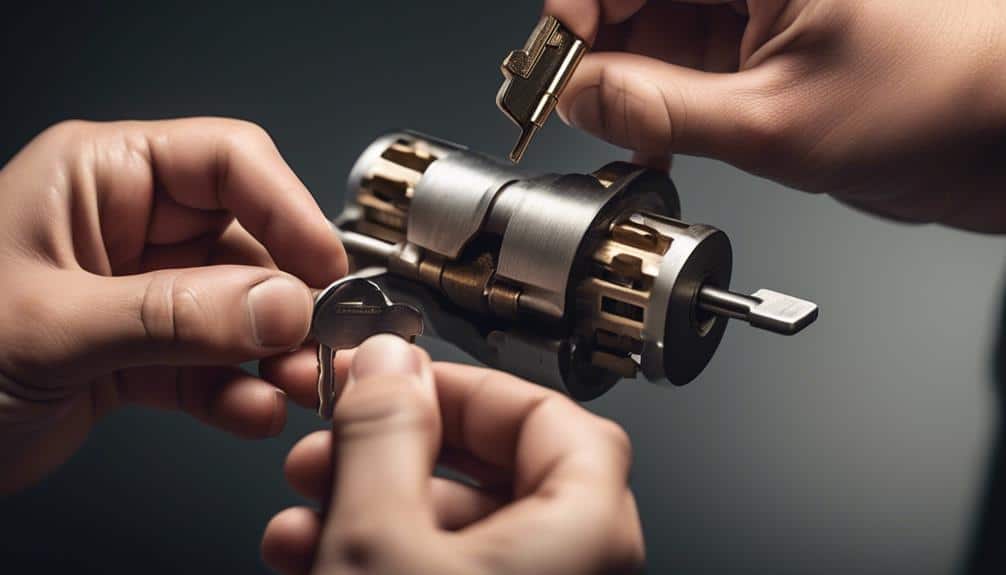
To ensure proper functionality, it's essential to thoroughly test and make any necessary adjustments to the lock. Lock testing allows us to verify that the lock operates smoothly and securely, while lock maintenance ensures that it remains in optimal condition. Here are some key steps to follow when testing and adjusting a lock:
- Test the key: Insert the key into the lock and turn it clockwise and counterclockwise to ensure smooth operation. Check for any resistance or sticking points.
- Check the latch: Close the door and test the latch to ensure it fully extends and retracts smoothly. Adjust the strike plate if needed to achieve proper alignment.
- Test the deadbolt: Extend and retract the deadbolt several times to ensure it operates smoothly. Adjust the strike plate and deadbolt alignment if necessary.
- Verify security: Test the lock's security features by attempting to manipulate or pick it. This will help identify any vulnerabilities that may need to be addressed.
- Lubricate moving parts: Apply a small amount of lubricant to the keyway, latch, deadbolt, and other moving parts to ensure smooth operation and prevent corrosion.
Thorough lock testing and maintenance are crucial to ensure the lock functions properly and provides the necessary security. Regular checks and adjustments can prevent potential lockouts or security breaches.
Secure the Lock With Additional Measures
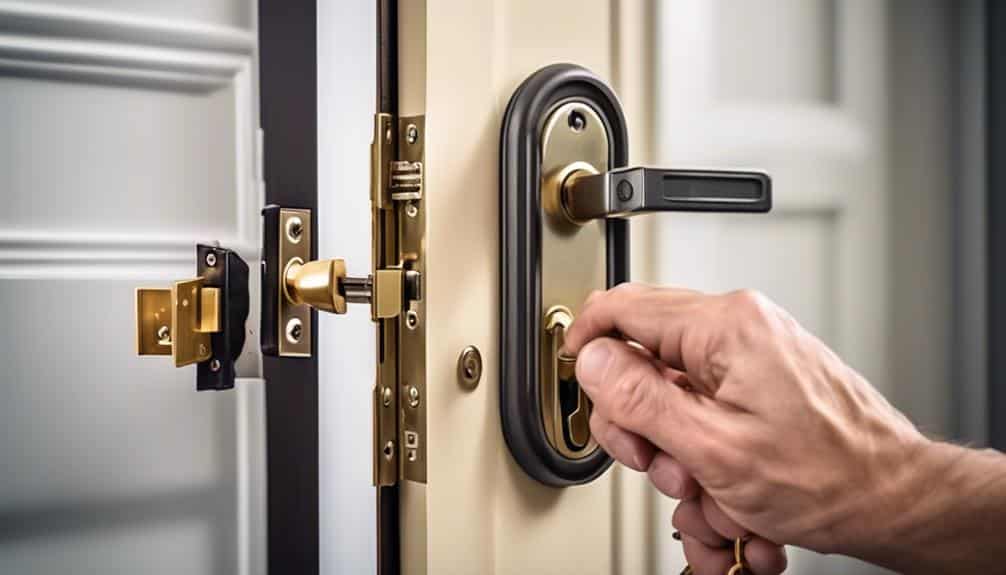
After thoroughly testing and adjusting the lock, it's important to implement additional security measures to further enhance its protection. These additional measures will reinforce the door frame and ensure that your lock is as secure as possible.
One effective way to reinforce the door frame is by using a door jamb reinforcement kit. This kit typically includes metal plates and screws that are designed to strengthen the weak points of the door frame, such as the strike plate and hinges. By installing these plates, you can prevent the door from being kicked in or forced open.
Another option for additional security is to install a security strike plate. This type of strike plate is typically made of heavy-duty metal and has longer screws to secure it to the door frame. A security strike plate provides added strength and durability, making it more difficult for an intruder to break the door down.
Additionally, consider installing a door security bar or a door security chain. These devices provide an extra layer of protection by preventing the door from being opened fully, even if the lock is picked or bypassed.
Implementing these additional security measures will significantly enhance the protection provided by your newly installed lock. By reinforcing the door frame and using additional security devices, you can create a robust defense against potential intruders.
Frequently Asked Questions
How Long Does It Typically Take to Install a Lock?
Installing a lock can be a breeze, but it all depends on various factors. Factors like the type of lock, complexity of the mechanism, and the experience of the installer can greatly affect the installation time.
However, there are common challenges that may arise during the process, such as misalignment or faulty parts, which can cause delays.
It's crucial to hire a professional locksmith who understands these challenges and can efficiently tackle them to ensure a quick and reliable installation.
Are There Any Specific Safety Precautions to Take During the Lock Installation Process?
When it comes to lock installation, there are a few common mistakes to avoid and safety precautions to take.
First, ensure you have the proper tools and equipment, such as a drill and screwdriver.
Always read the manufacturer's instructions carefully before starting the installation process.
Additionally, make sure to wear protective gear, such as gloves and safety glasses.
Can I Install a Lock on a Glass Door?
Installing a lock on a glass door requires careful consideration. Sliding glass doors present unique challenges, but with the right lock, it can be done. The best locks for glass doors are those specifically designed for this purpose. These locks usually have a strong adhesive or mounting system to secure them to the glass.
Additionally, it's important to ensure that the lock doesn't obstruct the door's movement. By following these guidelines, you can successfully install a lock on a glass door.
Is It Possible to Install a Lock on a Door That Already Has a Lock Installed?
Yes, it's possible to install a lock on a door that already has a lock installed. There are alternative lock installation methods that can be used in these situations.
One method is to install a deadbolt lock above or below the existing lock. This provides an extra layer of security.
Another method is to replace the existing lock with a lock that has a built-in deadbolt. Both of these options can help enhance the security of the door.
Can I Install a Lock on a Door With an Irregular Shape?
Yes, you can install a lock on a door with an irregular shape.
When installing a lock on a round door, it's important to choose a lock that's specifically designed for this type of door. There are locks available with adjustable backsets to accommodate different door thicknesses.
For an angled door, you may need to use a lock with an adjustable strike plate to ensure proper alignment.
It's recommended to consult a professional locksmith for specialized installations.

